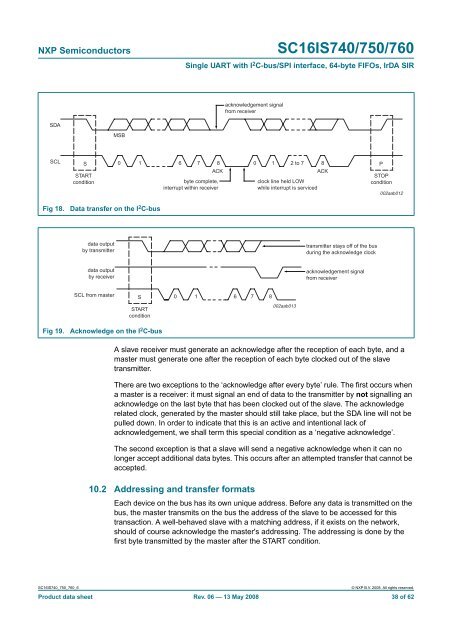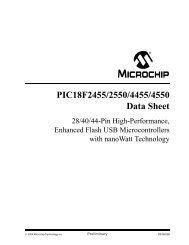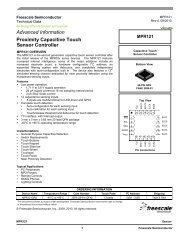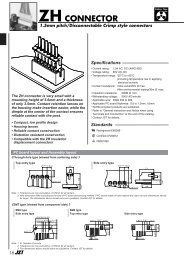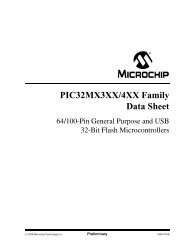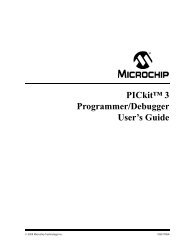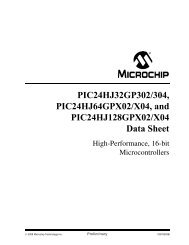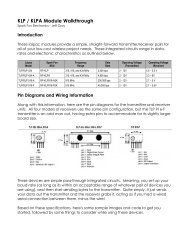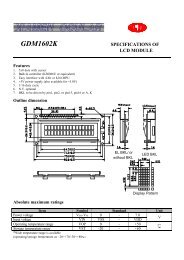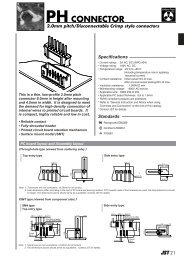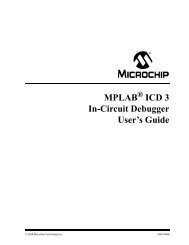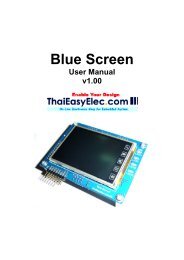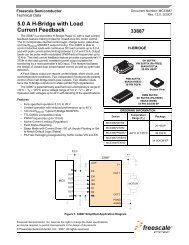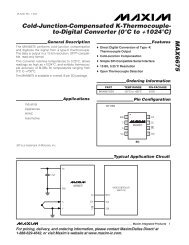SC16IS740/750/760 Single UART with I2C-bus/SPI interface, 64 ...
SC16IS740/750/760 Single UART with I2C-bus/SPI interface, 64 ...
SC16IS740/750/760 Single UART with I2C-bus/SPI interface, 64 ...
You also want an ePaper? Increase the reach of your titles
YUMPU automatically turns print PDFs into web optimized ePapers that Google loves.
NXP Semiconductors<br />
<strong>SC16IS740</strong>/<strong>750</strong>/<strong>760</strong><br />
<strong>Single</strong> <strong>UART</strong> <strong>with</strong> I 2 C-<strong>bus</strong>/<strong>SPI</strong> <strong>interface</strong>, <strong>64</strong>-byte FIFOs, IrDA SIR<br />
acknowledgement signal<br />
from receiver<br />
SDA<br />
MSB<br />
SCL<br />
S<br />
START<br />
condition<br />
0 1 6 7 8 0 1 2 to 7 8<br />
ACK<br />
ACK<br />
byte complete,<br />
interrupt <strong>with</strong>in receiver<br />
clock line held LOW<br />
while interrupt is serviced<br />
P<br />
STOP<br />
condition<br />
002aab012<br />
Fig 18.<br />
Data transfer on the I 2 C-<strong>bus</strong><br />
data output<br />
by transmitter<br />
transmitter stays off of the <strong>bus</strong><br />
during the acknowledge clock<br />
data output<br />
by receiver<br />
acknowledgement signal<br />
from receiver<br />
SCL from master<br />
S 0 1 6 7 8<br />
START<br />
condition<br />
002aab013<br />
Fig 19.<br />
Acknowledge on the I 2 C-<strong>bus</strong><br />
A slave receiver must generate an acknowledge after the reception of each byte, and a<br />
master must generate one after the reception of each byte clocked out of the slave<br />
transmitter.<br />
There are two exceptions to the ‘acknowledge after every byte’ rule. The first occurs when<br />
a master is a receiver: it must signal an end of data to the transmitter by not signalling an<br />
acknowledge on the last byte that has been clocked out of the slave. The acknowledge<br />
related clock, generated by the master should still take place, but the SDA line will not be<br />
pulled down. In order to indicate that this is an active and intentional lack of<br />
acknowledgement, we shall term this special condition as a ‘negative acknowledge’.<br />
The second exception is that a slave will send a negative acknowledge when it can no<br />
longer accept additional data bytes. This occurs after an attempted transfer that cannot be<br />
accepted.<br />
10.2 Addressing and transfer formats<br />
Each device on the <strong>bus</strong> has its own unique address. Before any data is transmitted on the<br />
<strong>bus</strong>, the master transmits on the <strong>bus</strong> the address of the slave to be accessed for this<br />
transaction. A well-behaved slave <strong>with</strong> a matching address, if it exists on the network,<br />
should of course acknowledge the master's addressing. The addressing is done by the<br />
first byte transmitted by the master after the START condition.<br />
<strong>SC16IS740</strong>_<strong>750</strong>_<strong>760</strong>_6<br />
© NXP B.V. 2008. All rights reserved.<br />
Product data sheet Rev. 06 — 13 May 2008 38 of 62


